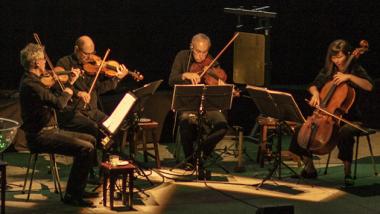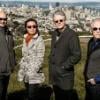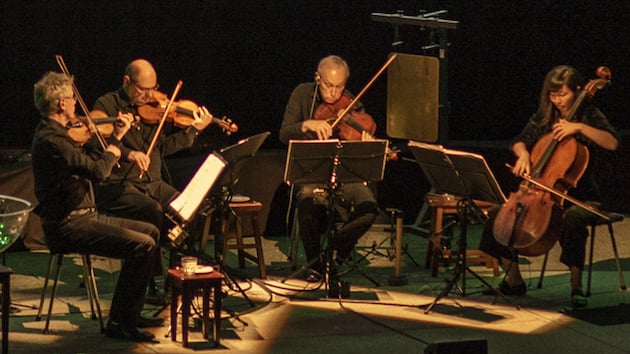
The Kronos string quartet presented an unexpected mix of visual music and musical film on Friday night at Stanford’s Bing Concert Hall. The musical highlights were Nicole Lizée’s Another Living Soul and Tanya Tagaq’s Sivunittinii.
Lizée’s piece is a world of sonic characters in wonderfully melancholic motion. It began with cellist Sunny Yang and violinist David Harrington wheeling whistling tubes to create mellow drones at a gently dissonant interval. Violist Hank Dutt and violinist John Sherba wove melodies around each other in the midst of the ongoing drones. Once Yang and Harrington picked up their instruments, floating vocalizations wafted through the ensemble until the piece’s central section, a musical homage to stop-motion animation, presented unpredictable foot stomping amid irregular rhythms on the instruments. Gravity tubes added their other-worldly timbre to the piece, and while they initially evoked laughter from the audience, Lizée deftly transforms the potential gimmickry into a luxurious sound, especially once the tubes were used to bow the string instruments, creating ethereal glissandi and percolating clicks from the toy’s inner tube.
Tanya Tagaq’s Sivunittinni (“the future ones”) is an attempt to present a musical image of land. Tagaq, well-known as an Inuit throat singer, recorded the music’s multiple lines one at a time and Jacob Garchik then impeccably transcribed them for string quartet. The string quartet version requires the performers to use a variety of extended techniques such as scraping the strings and brushing them like a drummer does a snare. The effects are stunning sonic imagery of groaning, wailing, shrieking, breathing, bird sounds, and something like sea-mammal noises. Tagaq’s thoughtful synthesis of this wealth of sounds was powerful and new.
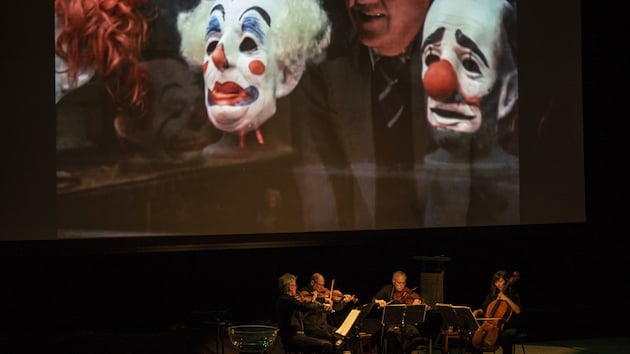
The billed item of the evening was The Green Fog, an adaptation of Alfred Hitchcock’s Vertigo using dozens of television and film clips shot or set in San Francisco. While the music composed by Jacob Garchik was effective (imagine if Steve Reich was writing film music and scored it for string quartet), the visuals were the highlight for me. Directors Guy Maddin, Evan Johnson, and Galen Johnson crafted something remarkable: a film that seems to make visual music. They treat each of the hundreds of clips they selected as though they are musical notes. So, in the midst of Vertigo’s storyline, tiny fragments are repeated in the way we accept repetition in music: many times in a row, returning later as if in recapitulation, strung together into visual melodies, or presented simultaneously as if they were harmonies or polyphony.
One effect of their approach is that it brings attention to sounds we normally ignore. In a number of rapid-fire clips depicting conversations between people, the audio track leaves out words but preserves the sounds immediately beforehand: we hear inhalations, sighs, and the initial vocalizations that flow into words. At times funny, this heightened awareness of human sound beyond words is also enlivening, a usually banal dimension of the everyday made aesthetic.
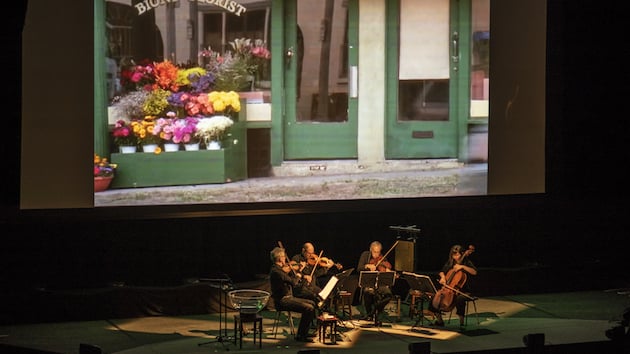
The polyphonic or simultaneous presentation of images was also breathtaking. Clips that involved screens became opportunities for the filmmakers to project unexpected footage (including an NSYNC music video) onto monitors in all sorts of contexts and transition seamlessly between groups of clips. The technique is also used to grapple with theme of surveillance as we, the viewers, repeatedly see someone watching something on a screen that is then brought to the fore, as if in a solo or cadenza, before returning to the watcher. At some moments the clips of the watcher are placed in another, monitored screen, bringing in multiple levels of surveillance that are at times comic, at times uncomfortable.
Before the concert, filmmaker Guy Maddin said that the team was “still not exactly sure what [they] made” with The Green Fog. It seems to me that their musically-filmed experience as well as Lizée and Tagaq’s works are opportunities take pleasure in new levels of sound and discover the visual joys of musical devices.

